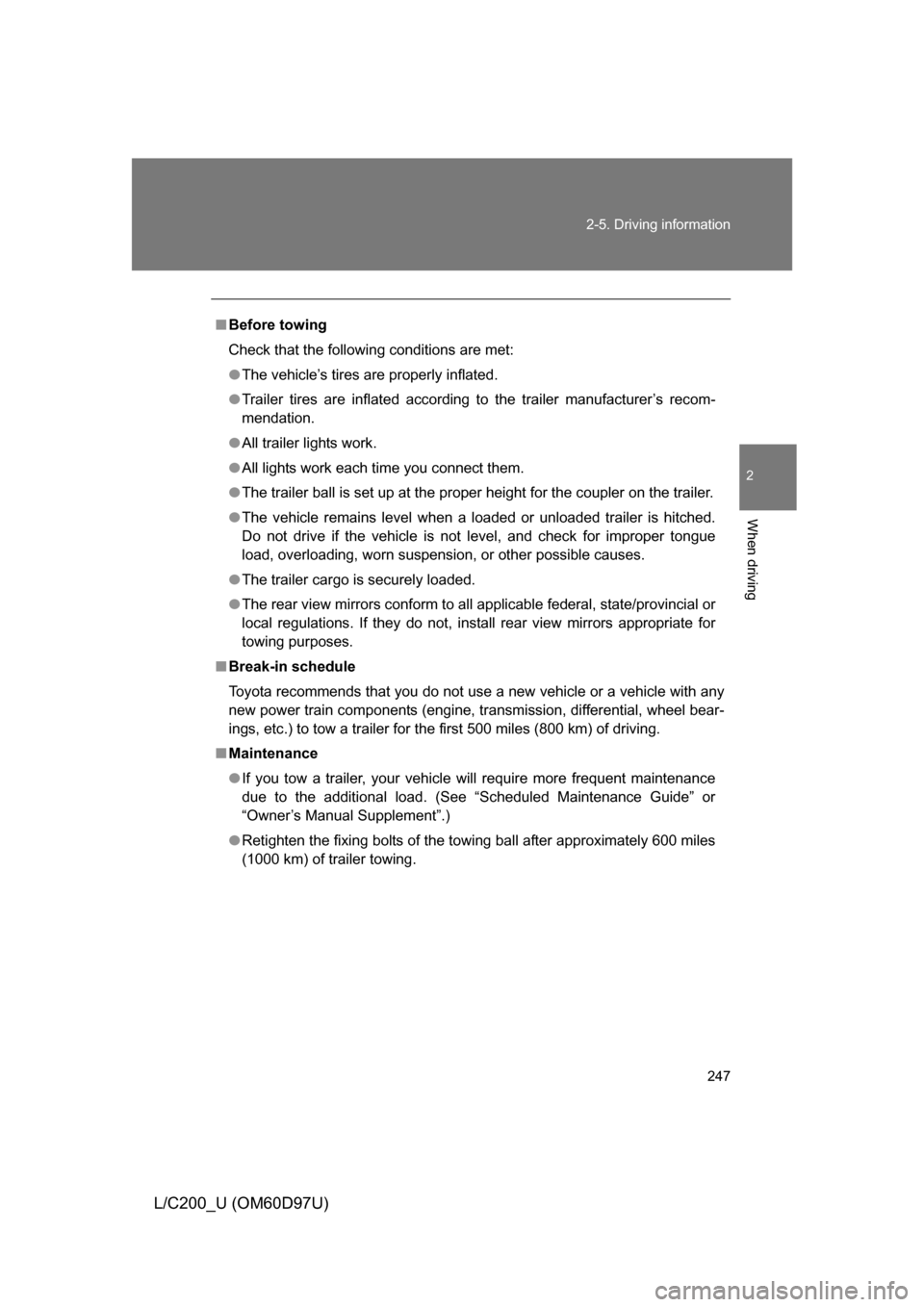Page 51 of 556
51
1
Before driving
L/C200_U (OM60D97U)
1-3. Adjustable components (seats, mirrors, steering wheel)
Front seats
Active head restraint
When a front seatback receives
a strong impact, the head
restraint moves slightly forward
and upward to help reduce the
risk of whiplash on the seat
occupant.
Seat position fore/aft control
switch
Seatback angle control
switch
Seat cushion (front) angle
control switch
Vertical height control
switch
Lumbar support control
switch (driver’s side only)
ITY13C034
Page 67 of 556
67
1-3. Adjustable components (s
eats, mirrors, steering wheel)
1
Before driving
L/C200_U (OM60D97U)
■Adjusting the height of the head restraints
■ Adjusting the second cen ter seat head restraint
Always raise the head restraint one level from the stowed position when
using.
Third outboard seats
To f o l d
Pull the head restraint angle
lever to fold the head restraint.
ITY13C040
Make sure that the head restraints are
adjusted so that the center of the head
restraint is closest to the top of your ears.
Page 71 of 556
71
1-3. Adjustable components (s
eats, mirrors, steering wheel)
1
Before driving
L/C200_U (OM60D97U)
\
Third center seat belt
The third center seat belt is a 3-point type restraint with 2 buckles.
Both seat belt buckles must be co rrectly located and securely latched
for proper operation.
Make sure that the buckle with
the gray buckle release button is
securely latched for ready use of
the center seat belt.
■Adjusting the height of th e belt (front, second outboard
seat)
Down
Up
Move the height adjuster up
and down as needed until you
hear a click.
1
2
ITY13C055
ITY13C049
Page 124 of 556
124 1-7. Safety information
L/C200_U (OM60D97U)Forward facing—Convertible seat
Booster seat
■
When installing the child restrain t system on the front passenger seat
When you have to use a child restraint
system on the front passenger seat,
adjust the following:
●The seatback to the most upright posi-
tion
● The seat cushion to the fully rearward
and highest position
● The seat belt height to the lowest posi-
tion
ITY17C108
Page 220 of 556
220
L/C200_U (OM60D97U)
2-5. Driving information
Off-road precautions
Off-road vehicle feature● Specific design characteristics give it a higher center of gravity
than ordinary passenger cars. This vehicle design feature causes
this type of vehicle to be more likel y to rollover. And, utility vehicles
have a significantly higher rollover rate than other types of vehi-
cles.
● An advantage of the higher ground clearance is a better view of the
road allowing you to anticipate problems.
● It is not designed for cornering at the same speeds as ordinary
passenger cars any more than low-slung sports cars are designed
to perform satisfactorily under of f-road conditions. Therefore, sharp
turns at excessive speeds may cause rollover.
This vehicle belongs to the utility vehicle class, which has higher
ground clearance and narrower tread in relation to the height of its
center of gravity to make it capable of performing in a wide variety
of off-road applications.
Page 247 of 556

247
2-5. Driving information
2
When driving
L/C200_U (OM60D97U)
■
Before towing
Check that the following conditions are met:
● The vehicle’s tires are properly inflated.
● Trailer tires are inflated according to the trailer manufacturer’s recom-
mendation.
● All trailer lights work.
● All lights work each time you connect them.
● The trailer ball is set up at the proper height for the coupler on the t\
railer.
● The vehicle remains level when a loaded or unloaded trailer is hitched.
Do not drive if the vehicle is not level, and check for improper tongue
load, overloading, worn suspension, or other possible causes.
● The trailer cargo is securely loaded.
● The rear view mirrors conform to all applicable federal, state/provincial or
local regulations. If they do not, install rear view mirrors appropriate for
towing purposes.
■ Break-in schedule
Toyota recommends that you do not use a new vehicle or a vehicle with any
new power train components (engine, transmission, differential, wheel bear-
ings, etc.) to tow a trailer for the first 500 miles (800 km) of driving.
■ Maintenance
● If you tow a trailer, your vehicle will require more frequent maintenance
due to the additional load. (See “Scheduled Maintenance Guide” or
“Owner’s Manual Supplement”.)
● Retighten the fixing bolts of the towing ball after approximately 600 miles
(1000 km) of trailer towing.
Page 508 of 556
508
L/C200_U (OM60D97U)
6-1. Specifications
Maintenance data (fuel, oil level, etc.)
Dimensions and weights
*:Unladen vehicle
Overall length194.9 in. (4950 mm)
Overall width77.6 in. (1970 mm)
Overall height *74.0 in. (1880 mm)
Wheelbase112.2 in. (2850 mm)
TreadFront64.6 in. (1640 mm)
Rear64.4 in. (1635 mm)
Vehicle capacity weight
(Occupants + luggage)1235 lb. (560 kg)
Towing capacity
(trailer weight + cargo weight)8500 lb. (3856 kg)
Page 523 of 556
523
6-1. Specifications
6
Vehicle specifications
L/C200_U (OM60D97U)
Tire size
■ Typical tire size information
The illustration indicates typical
tire size.
Tire use
(P = Passenger car,
T = Temporary use)
Section width (millimeters)
Aspect ratio
(tire height to section width)
Tire construction code
(R = Radial, D = Diagonal)
Wheel diameter (inches)
Load index (2 or 3 digits)
Speed symbol
(alphabet with one letter)
■ Tire dimensions
Section width
Tire height
Wheel diameter
P285/60R18 114V
ITY61C011
ITY61C012